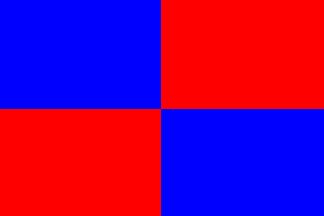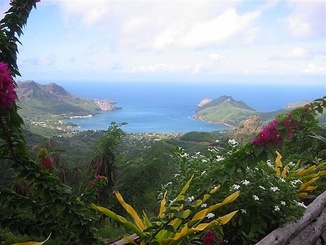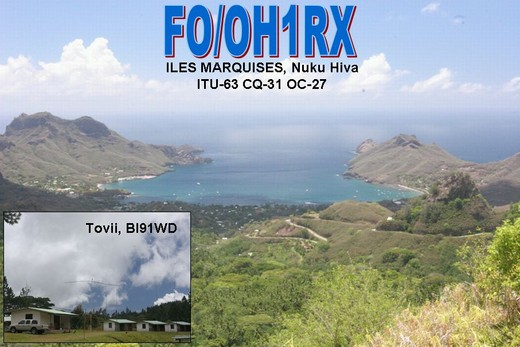- About QSL
- OH1RX, the DX Hunter
- Where Shall We Go Next ?
- FO/OH1RX Marquesas Islands Jan 2008
- T30DX, Western Kiribati Jan. 2006 : CANCELLED
- OH0Z
- Ham Pics Gallery - not so serious
- FO/OH6KN 2004
- WRTC2002
- JOTA 2005
- JOTA 2006
- SRAL Meeting in Salo 19th Nov., 2005
- CCF / OHDXF Cruise 2006
- SOUTH CHINA SEA DX TEAM
- Boeltzenberger DX Club
- Ham Links
- MRD 2007
- OH10TA April 2007
- OX/OH1RX 2007
- LA/OH1RX 2008
- CONTEST SCORE LIST
- OG50F CQWWCW 2008
- Visalia 2009
- DU/OH1RX Nov 2009
- CWT
- TF/OH1RX & TF4X 07 2010
- OH1F SAC SSB M/M 2010
- ES9C CQWW CW M/M 2013

|

Marquesas Islands / Nuku Hiva
|
Kaoha Nui !
OH Pacific Team hit the Marquesas Islands in January 2008.
You may read more from : www.sm0w.com/marquesas or the QST May 2008 Article.
The body text is here below:
OH PACIFIC TEAM – FO/OH1RX DXPEDITION TO THE MARQUESAS ISLANDS
BY VEIJO KONTAS, OH6KN & JOUKO HAYRYNEN, OH1RX
BACKGROUND AND OPERATING PHILOSOPHY
The OH Pacific Team was established by Veijo, OH6KN; Henry, OH3JR; and Veko, OH1AWW; in the late 1990s to get to the serving end of the pile, especially on the low bands. You may have worked 5W0VK, A35VK or FO/OH6KN from the Austral Islands. The operating philosophy is a kind of mental filter who is interested to join an OH Pacific Team DXpedition and who is not. The simple rules of selecting location and operations are; relatively rare DXCC, reasonable access, QTH suitable for low bands (preferably by the sea and low local noise) and “light but loud” antennas and radios/PAs. The team will stay in a QTH for a longer period to justify the time and money invested to the trip. And since OH “enjoys” sub-zero temperatures in mid winter, we prefer to set the sails for warm WX!
MARQUESAS
The Marquesas Islands lie between 600 and 900 km south of the Equator and about 1600 km northeast of Tahiti. Nuku Hiva is the largest Island of the group. The island is of volcanic origin and very mountainous with the peaks rising to 1300 m. The island coast has no reef or coral-clad lagoons.
Recent archaeological findings suggest that the island was settled some 2000 years ago. By the 13th century the population had reached its maximum of 100,000. Huge fortification complexes had been built on the central plateaus of the island.
The first European to visit the Marquesas was Alvaro de Mendana in 1595. He named the islands Las Islas de Marquesa de Mendoza and claimed them for Spain. It took almost two centuries before the next white visitor, Captain James Cook landed in 1774. This opened the islands to the outside world. In 1842 the French took formal possession of the islands.
Once big in numbers the population had drastically decreased to fewer than 6000 by 1872 – violence, diseases, demoralization. Today about 2000 people inhabit the island, mainly in the town of Taiohae. On the north coast lies the second main village Hatiheu, where the ruins of once great civilization takes your imagination to wild levels.
PREPARATIONS
How would you feel, if three days before the deadline for your airfreight to leave from OH to FO you did not have confirmed transport to and fro, only either or. Yes, we felt the same – shaking. But a miracle happened and we managed to get the gear on air (without knowing how to get them back five weeks later).
Spiderbeam makes an excellent light weight antenna for DXpeditions. But it is good to know, that a fair amount of preparatory work is needed for fluent assembly onsite. This work was mainly done in a hotel room in Los Angeles, while trying not to upset the fire alarms. After a long day of measurements, wire cutting, knot tying and heat shrinking the wire wonder was ready to go for the action.
On the 4th of January all the team members got together ( Jouko OH1RX + xyl Merja, Pertti OH2PM + yl Kirsti, Veijo OH6KN and Juha OH8NC) and after a mandatory visit to the Chinese Theatre to greet Marilyn we flew off to Tahiti to pick up the ham licenses during the 14 hour stop over. It took 4 hours of negotiations and countless calls to Finland to sort the license hassle. CEPT and HAREC were not fully known to local authorities and all the commas and full stops had to be examined with care. Finally we made it and a quick email to Teemu, SM0W, produced our call sign to the web: FO/OH1RX.
Getting to Nuku Hiva is easy. Three times a week there is a scheduled flight from Papeete. When we say easy, we mean a max of 5kg of hand luggage and max of 20kg of check-in. And we had 450kg of payload to ship. It helps, if you book the cargo beforehand, but in our case the confirmation was lost and we had to pay heaps of Pacific Francs (to be refunded 6 weeks later by Air Tahiti).
UP AND QRV
We arrived at the Tovii site late in the afternoon and the thirst for QSOs was burning. The first antenna to be set up was the R8000, but it took quite a few hours in heavy rain with a few wrong parts to get it erected. Eventually with a few “Perkele’s” we were on the air January 10 at 0825Z with the first QSO going to ZL2GEO and from that point on it was true YEEHAA!!!
In humid and cool conditions we erected the spider and phased verticals for 40m and 30m. Tovii is located about 800m ASL and the temperature range is between 16C and 22C (60-71F). Like an OH mid summer!
During the late afternoon of the second day we packed our low band gear into two pickup trucks and headed for our second QTH, which was Hatiheu on the northern coast. Pouring rain, dark night and narrow, curly and unpaved mountain road was our Camel Trophy. After two hours and 50km we arrived at Hatiheu to find out that our bungalows were taken by a Ukrainian satellite tracking team and there was no other place to even consider putting up a station. We went back to Tovii in the middle of the night to change operators on the radio. Veijo, being persistent, made another try the following day in Hatiheu. Negotiations with UR guys did not work out well and we had to accept that booking made three months in advance is worth nothing in this first – come – first – served culture.
So with the low band antennas up at Tovii village on the 3rd evening we had the set up done and pile up rally started.
STATION
The station was set up at a farm in the Tovii village in the central part of the island. The location was 800m ASL, but still with some surrounding peaks, one being directly to the North (EU/US/JA). But apparently it didn’t affect us as much as we had anticipated. There was plenty of space on the farm thus we could set up the antennas well. The biggest problem was freely walking cows, horses, chickens, etc. and especially their slippery landmines in the darkness.
The station consisted of two IC-756 PRO III with FinnFet 500 watt linears. For keying, CAT and RTTY interface we used microHAM boxes. Tuners were needed for some of the antennas. The antennas consisted of the following: 160m vertical was built with an 18m fiberglass pole and 43 meters of wire bent into an L shape along with four elevated radials. The 80m antenna had two 18m fiberglass poles with 21 meters of wire and four elevated radials each. The phasing was done using a Comtek 2 array box. The 40/30m main antenna consisted of two 10m fishing rods with both 40m/30m wires attached. Both verticals had two elevated radials for each band. The main high band antenna was the five band Spider at a height of 11m with 2-4 elements per band. The R8 was our general purpose radiator for the 2nd station.
The antennas were grouped so that we could run two stations at the same time for most of the bands. This is especially important for 30-160m during night time and during sun set/rise. The distance between the chalets and antennas were 70-80m and with stubs and band filters the situation was roughly under control.
For logging software we used Wintest, which is great for expeditions. Its RTTY interface is also good, very similar to normal CW/SSB usage.
OPERATING EXPERIENCE
The QTH was surprisingly noiseless and we could typically hear much better, than our counterpart at the other end of the signal. We planned certainly to have the low band site by the sea, but it didn’t materialize. In the end it is difficult to say, how many QSOs we lost. The formula was between noiseless mountain QTH compared to seaside with probably some noise from the electricity and TV, etc.
On 160m the openings to Europe were not good. ON4UN was heard for a few calls. J5C was heard on for two hours around sunrise one morning. On 80m Europe and US east coast Qs were quite numerous. The conditions to Europe most typically favoured West Europe, but also quite a few Scandinavians and southern Europeans made it into the log. On 80m we could switch directions with the Comtek box and sometimes it played a key role especially to EU. Mostly the Qs came via the short path.
On 40 meters the woodpecker was mostly killing the band. On 40/30 EU was workable, but the signals were not strong. Mother Nature had blessed us with poor propagation and this affected a lot the high band Qs to Europe.
RTTY was fired up for the last few days and it was great fun. Some of the operators made their first RTTY Qs in many decades.
STATISTICS
The total number of QSOs was 14,478, of which 3,343 were on SSB (23%), 10,667 on CW (74%) and 467 on RTTY (3%). One of the key focuses was low bands (160-30m). There we had a total of 7560 Qs on the low bands (52%), of which we had 4,413 Qs (58%) to W/VE, 1,451 Qs (19%) to JA and 863 Qs to Europe (11%). On 80m we had 400 Qs to Europe.
The band statistics were as follows:
|
Band totals |
160 |
80 |
40 |
30 |
20 |
17 |
15 |
12 |
10 |
RTTY |
|
Total Q |
742 |
2915 |
2281 |
1622 |
4495 |
2139 |
282 |
1 |
1 |
467 |
|
W/VE |
553 |
1448 |
1393 |
1019 |
2950 |
1701 |
239 |
0 |
0 |
321 |
|
JA |
125 |
767 |
304 |
255 |
917 |
203 |
0 |
0 |
1 |
82 |
|
Europe |
0 |
400 |
299 |
156 |
121 |
29 |
3 |
0 |
0 |
3 |
Log Search at: www.sm0wka.com/marquesas
FEEDBACK AND IMPROVEMENTS
A good linear amplifier plays a key role on the low bands. We burnt our 800W amplifier the first second and had to survive with two 400 watt ones. For the next trip we will certainly bring full KW output amps. We’re working on a spec/concept for a special expedition amplifier. Hopefully we can get someone to build them for us.
The 18m long (whale) fishing poles from Spiderbeam were light weight and good for 80/160m GPs. They were also easy to erect and seemed to be sturdy enough with one set of guy wires. OM Cornelius, DF4SA, gut gemacht! (Translation – well made!)
A real time log is important to avoid duplicate Qs. We had it running nicely after the first two days. A big thanks to Teemu, SM0WKA, and Richard, SM6U, for the WEB and log updates. The web address is www.sm0wka.com/marquesas.
Reception is everything when propagation is as bad as it was for us. We were really lucky to locate an almost noiseless spot on the island. So, we did hear you all. Sorry, if you did not get a QSO due to poor propagation. The openings on 20m and 15m were extremely short (10-20mins), especially to EU and the US East Coast.
QRM and fake QSOs were the new phenomena to us. Yet French Polynesia does not have many active hams, our presence seemed to be too much for a lad near by. Well, this was nothing compared to pile up behaviour in good old Europe, sigh.
The other, more serious finding was that some hams used remote stations on the West Coast to get a QSO on 160m and 80m under a European call sign. Since we did not establish a pilot station in W6, it is close to impossible to verify good QSOs from bad ones.
What would you do? Either you just work all without hesitation or you start to police the bands with half a dozen friends around the globe. We hereby encourage constructive debate on the issue. The credibility of the whole DXCC and IOTA hunting is at risk now.
XYLs/YLs play an important role. Kirsti and Merja were excellent in taking care of logistics, food supply, our well being and helping in antenna installations. In addition they tamed the cows and calves who tried to destroy our installations numerous times. Big hugs to our ladies!
WHERE TO NEXT?
The clock is ticking. When Santa Claus is loading his sleigh, we might be on our way to give you another low band experience from “a DX location in the sun”. So, stay tuned and meanwhile lads, do build some innovative antennas for TX and RX to help the OH Pacific Team log you again. CUL!


